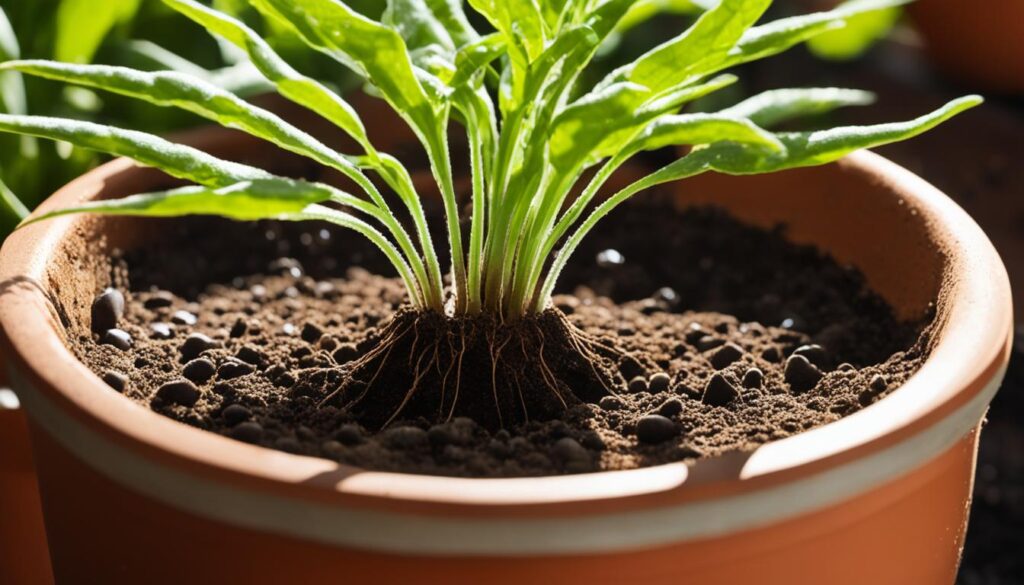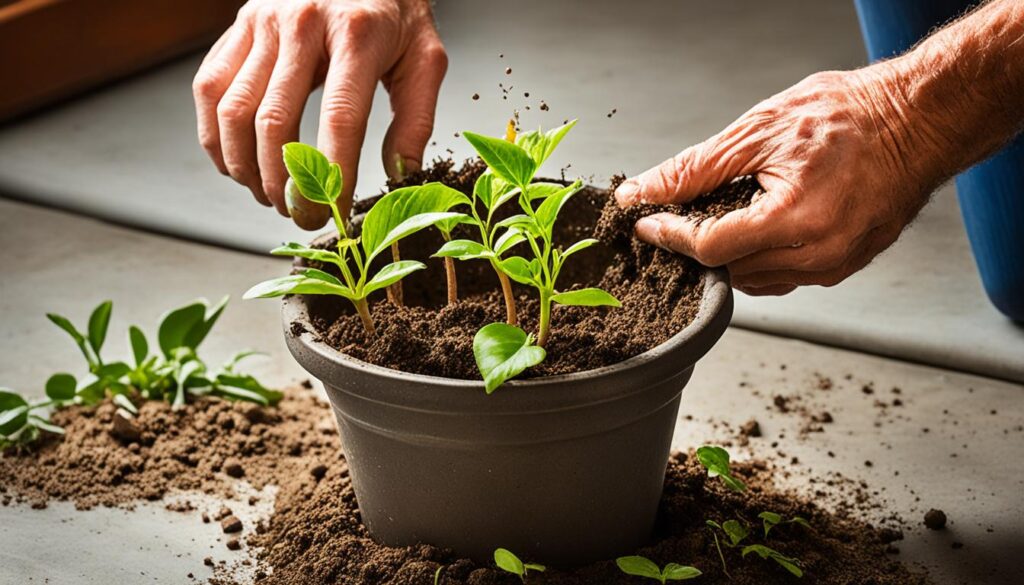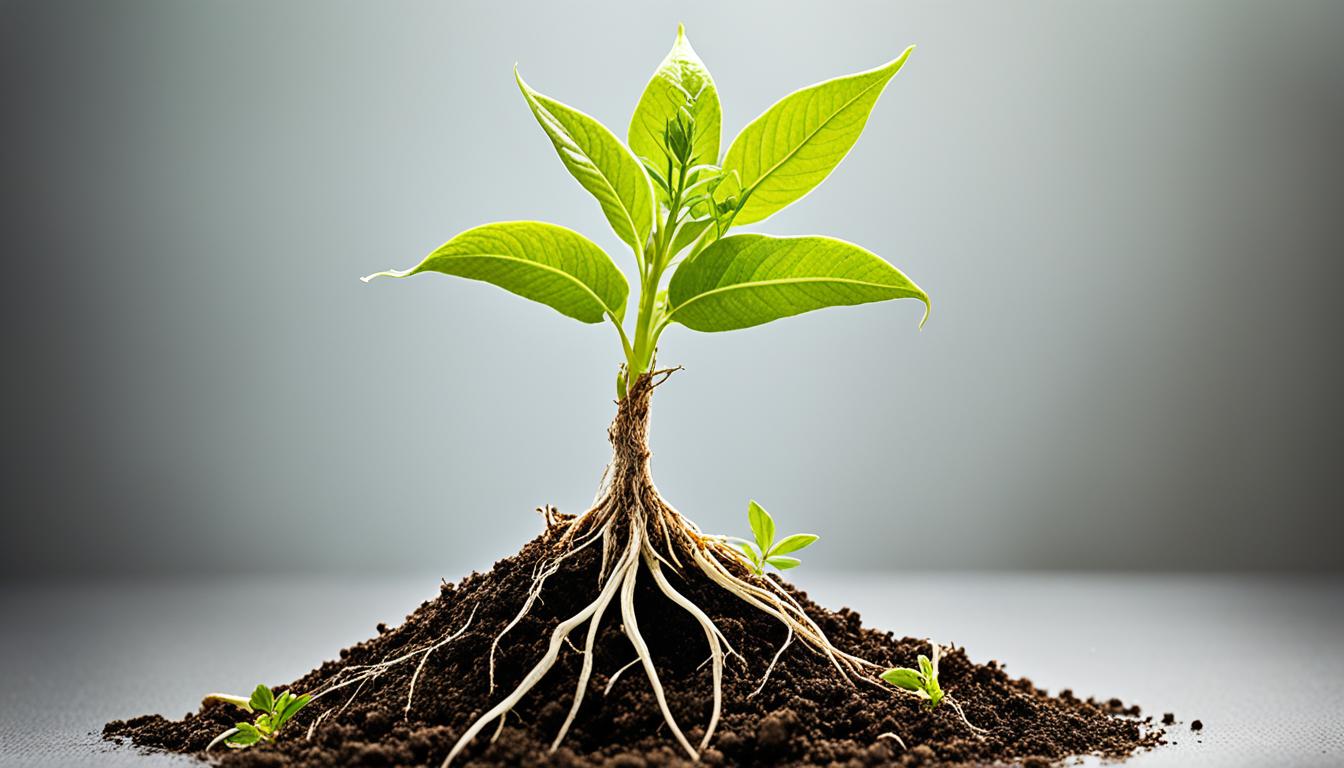Are you trying to save your favorite houseplant? Don’t lose hope! Many revive dying houseplants can come back to life, even if they look hopeless. We’ll show you how to fix and rejuvenate withered foliage in this guide.
Your houseplant might be dying, but with the right care, you can resuscitate wilting plants and houseplant resuscitation. Are you ready to learn how to save your plants? Let’s start and discover the secrets of houseplant care.
Signs Your Houseplant is Struggling
It’s key to spot early signs of a struggling houseplant to help it recover. Look closely at your plant’s look and growth to catch issues early. Here are the common signs of trouble you should watch for.
Inspecting for Signs of Life
First, check the stems of your houseplant. They should be flexible and green. For woody stems, press your fingernail gently to see if there’s green under the bark. Also, take the plant out of its pot to check the roots. Healthy roots are white or yellow and plump. Brown, mushy roots mean the plant is struggling.
Common Indicators of Plant Distress
Watch your houseplant closely for signs of trouble. These signs include:
- Falling leaves: Premature leaf drop could mean the plant lacks water, gets too much water, or lacks nutrients.
- Drooping stems: Limp stems suggest the plant needs more water or is diseased.
- Signs of pests: Visible insects, webs, or spots could mean pests like spider mites or aphids are present.
Knowing these signs of dying houseplant, plant distress symptoms, and houseplant health indicators helps you spot and fix problems. This way, you can help your struggling houseplant recover.
“Paying attention to the subtle changes in your plant’s appearance can make all the difference in catching problems early and getting your houseplant back on the road to recovery.”
Overwatering: A Common Cause of Houseplant Decline
Overwatering is a top reason why houseplants die. When soil gets too wet, roots can’t breathe. Knowing the signs of overwatering and acting fast can save your plants and stop future problems.
Identifying Overwatering
Look for drooping leaves and stems if your plant is overwatered. The soil might stay wet all the time, not drying out like it should. You might also see fungus or a bad smell, which means root rot.
Treating Overwatered Plants
Lower the amount of water you give your plant if it’s overwatered. Let the soil dry out a bit before watering again. Don’t let the plant sit in water. If you see mushy roots, cut them off and put the plant in new soil that drains well.
| Symptom | Cause | Treatment |
|---|---|---|
| Drooping, wilting leaves and stems | Overwatering | Reduce watering frequency and allow soil to dry slightly between waterings |
| Browning or yellowing foliage | Overwatering | Reduce watering frequency and allow soil to dry slightly between waterings |
| Mushy, brown roots | Root rot due to overwatering | Trim off affected roots and repot in fresh, well-draining soil |
By spotting overwatering signs and acting quickly, you can save your houseplants. Adjust how often you water based on each plant’s needs and your home’s conditions.
Underwatering: Another Threat to Plant Health
Underwatering can harm your houseplants just like overwatering does. When the soil gets too dry, your plants may show signs like wilting leaves, dry tips, and yellow leaves at the top. These signs mean your underwatered houseplants are not doing well.
Recognizing Underwatering
Keep an eye on how moist the soil is for your plants. Signs of underwatering include:
- Wilting or drooping leaves
- Dried or brittle leaf tips
- Yellowing foliage near the top of the plant
If the soil is too dry, it’s hard to get water to it with a regular can. Using the bottom watering plants method can help.
Bottom Watering Technique
To help your underwatered houseplants, try bottom watering. Put the whole pot in water and let the soil soak up moisture from the bottom. Soak the plant for 30 minutes, then drain it well. This way, the roots get the water they need to rehydrate dry plants and grow healthy again.

By spotting underwatering signs and using bottom watering, you can make your thirsty houseplants healthy and strong again.
Revive dying houseplant by Repotting
If your houseplant is struggling, repotting might be the answer. Knowing the signs of a rootbound plant and how to repot can help your plant come back to life.
Signs of a Rootbound Plant
Look for signs that your plant needs a bigger home. Wilting leaves, soil pulling away from the pot, and roots circling or growing out of holes mean it’s time for a bigger pot.
Proper Repotting Techniques
- Gently remove the plant from its current pot, taking care not to damage the roots.
- Inspect the root system and, if necessary, carefully loosen and separate any tangled or circling roots.
- Select a new pot that’s only slightly larger than the previous one, as overpotting can lead to issues.
- Fill the new pot with fresh, high-quality potting soil, then replant your greenery, ensuring the soil line is at the same level as before.
- Water the plant thoroughly and provide it with the necessary care and attention to help it recover.
Understanding the signs of a rootbound plant and proper repotting can help you revive plants by repotting. With patience and the right steps, your repotting houseplants efforts can lead to a healthy, thriving plant.

“The key to reviving a dying houseplant is often found in the roots. Repotting can provide the solution to many plant health issues.”
Pruning for Plant Revival
Pruning can help revive a struggling houseplant. Dead leaves won’t come back, and trimming removes excess foliage that drains resources. Cutting stems encourages new growth, making the plant healthier.
For leggy plants, cut stems by one-third and trim dead stems to where you see green. Cutting up to one-third to one-half of the foliage helps the root system recover.
Proper pruning houseplants is key for rejuvenating plants by pruning. By trimming dying leaves, your houseplant can bounce back from distress.
- Identify the dead or dying leaves and stems on your houseplant.
- Use clean, sharp pruning shears to cut back stems by one-third, making the cuts just above a leaf node.
- Trim any dead or dried-out leaves, cutting them off at the base of the stem.
- Remove up to one-third to one-half of the plant’s overall foliage to reduce stress on the root system.
- Discard the pruned material to prevent the spread of any diseases or pests.
| Pruning Technique | Benefits |
|---|---|
| Cutting back stems | Encourages new growth and a denser, healthier canopy |
| Trimming dying leaves | Removes excess foliage that drains the plant’s resources |
| Reducing overall foliage | Eases stress on the root system, allowing the plant to focus on recovery |
“Proper pruning is essential for the long-term health and vigor of your houseplants.”
By using these pruning techniques, your struggling houseplant can regain strength and thrive. Be patient and let the plant recover after pruning.
Pest Control for Unhealthy Plants
Pests can harm your houseplants. Look for signs like webbing, discolored leaves, or pests. Common pests like mealybugs, whiteflies, and spider mites are easy to manage.
Common Houseplant Pests
Start by spraying water to remove pests. This can be a simple way to fight back. If pests don’t go away, try insecticidal soaps or neem oil.
Treating Pest Infestations
- Remove any affected leaves to stop pests from spreading.
- Watch the plant closely after treatment to see if the problem is fixed.
- If pests keep coming back, you might need to get rid of the plant and start fresh.
Stay alert and use the right treatments to revive plants with pests. Quick action helps your houseplants recover and thrive.
Conclusion: Be Patient and Provide Proper Care
Reviving a dying houseplant takes patience and a deep understanding of what your plant needs. First, figure out the problem, like too much water, not enough water, or pests. Then, use the right fixes to help your plant recover.
Getting your plant back to health can take a while, maybe even a month or more. Don’t get frustrated if you don’t see changes right away. With the right care and patience, your houseplant can regain its beauty and thrive for years.
Learning how to revive dying houseplants makes your home greener and healthier. It also shows how strong nature can be. Enjoy the process, celebrate your wins, and be proud of bringing life back to your plants.
FAQ
How can I tell if my houseplant is struggling?
Look for signs like falling leaves, drooping stems, and pests. Check the stems, roots, and how the plant looks overall to figure out the problem.
What causes overwatering in houseplants?
Overwatering happens when the soil gets too wet, cutting off air to the roots. This makes leaves and stems droop, and they may turn brown or yellow.
How can I revive an underwatered houseplant?
For a dry plant, try the bottom watering method. Put the whole pot in water so the soil absorbs moisture from the bottom. This helps the roots get the water they need.
How do I know if my houseplant is rootbound?
Rootbound plants show signs like wilting leaves, soil pulling away from the pot, and roots circling or growing out of holes. Check the roots by gently removing the plant from its pot to see if they’re tangled.
How can pruning help revive a struggling houseplant?
Pruning cuts off dead leaves, saving the plant’s energy. It encourages new growth and makes the plant look fuller and healthier. Cutting off some foliage helps the roots recover faster.
How do I get rid of pests on my houseplant?
First, blast the pests with water. Then, use insecticidal soaps or neem oil if needed. Remove any damaged leaves to stop the infestation. If it doesn’t work, you might need to get rid of the plant to protect others.





Pingback: English Ivy Indoors: How to Grow This Elegant, Cold-Tolerant Vine Successfully
Pingback: Dancing Bones Cactus (Hatiora salicornioides)
Pingback: Shingle Plant (Rhaphidophora hayi
Pingback: Fiddle Leaf Fig, The Iconic Statement Plant That Instantly Elevates Any Space
Pingback: 16 Must-Know Houseplant Trends for 2025 – What's Hot This Year? - Trusted House Plant Guide